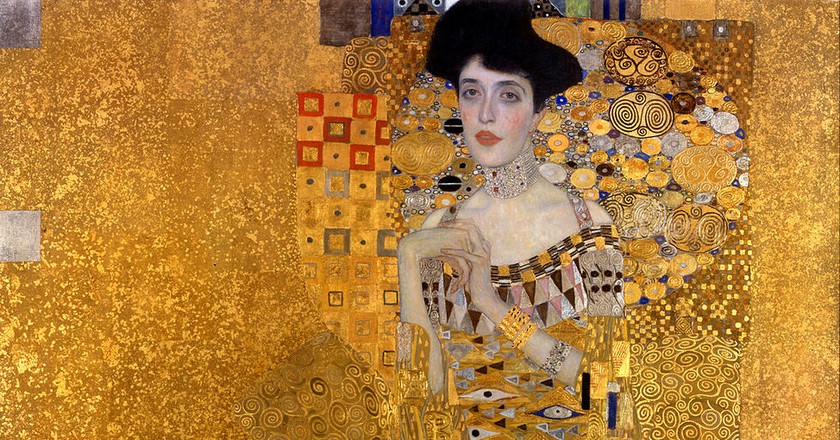Just to remind you what "Death and Life" looked like. (1900)
Here are a few more famous pieces of his.
The Kiss

Golden Tears

Portrait of Adele Bloch-Bauer
I believe the reason behind this was due to his poverty growing up as his father's occupation was an unsuccessful gold engraver. Because of this, Gustav had to take on the majority of the financial roles within his family, which was only amplified when his father and brother both died within a close time period of each other. I think his gold incorporated-paintings pay respect to that aspect of his life that so greatly defined him.




4 comments:
That’s very interesting, Farah! I didn’t know that about the gold. We touched on the purple a little bit in class, but I think it’s worth repeating: I love Gustav’s choice of having the skeleton guy (a symbol for death, of course) wear purple. Whether or not Gustav intended on this I am not sure, but the the purple—the color of royalty—shows that nobody is immune to death; not even royalty! Whereas many artists probably would have shyed away from a statement so bold, Gustav does not.
Hey, Farah! Thanks for sharing this unique artwork and for giving us some perspective into Klimt's life. When I looked at "The Kiss," it just looked so familiar, but I'm not sure if I've ever actually seen it before.
Here are my thoughts: I'm torn! I'm really not sure whether it's depicting lust or love between the man and the woman (at least at its most basic level). It certainly seems as though the two are passionately embracing/kissinf, and clearly, there's some chemical attraction. The way the woman's arm is draped around the man's neck certainly indicates some sort of attachment and connection. Furthermore, the way her hands clutch the man's neck and hand seems to reveal that she's experiencing some kind of pleasure. She's also kneeling, and Klimt's depiction of her toes bending adds a certain tension to the piece. In my opinion, the artist demonstrates his skill here; by depicting slight (but nonetheless telling) movements in his subjects, he conveys tension and emotion. Obviously, there's some kind of "special" moment going on here, and my best conclusion is that it's a mixture between lust and love. The bed of flowers beneath them, to me, represents vitality but also the purity and natural aspect of love. Also, the man and woman are both clothed, which makes the painting kind of chaste. The eroticism emerges not from nakedness (as in other works of art) but from real, passionate love...perhaps? I'm definitely not the expert! It's just speculation. Lastly, at first I thought the woman was sort of in a position of submission, but when I kept looking and thinking, my opinion changed. In the art Farah has presented us with, Klimt paints a lot of women, and none of them really seem weak. In "The Kiss," it actually seems like had the woman been standing, she would have been taller. And really, the two seem to be equally enjoying the moment. If anything, the woman seems to have the power. Klimt chooses HER face to paint. He focuses on her pleasure and her emotions. In fact, her feet are bound to the flowery earth below the couple; she is a powerful, natural, feminine beauty. Once again, it seems like the primary subject of Klimt's painting is the woman. I'm willing to bet he admired woman and enjoyed their company in his lifetime. (Honestly, I don't really think this last detail is all that important; it just caught my eye during my initial viewing of the painting.)
What do y'all think?
I'm so glad you shared, Farah! These pieces are stunning and I think your interpretation of his motives behind using gold is spot on. Furthermore, I recognize a few of these paintings, however I had never had a name to put to them. In particular, the last painting is the main point of a movie I once saw, "Woman in Gold". This film is based on the true story of Maria Altmann, a Jewish refugee who fought the government of Austria for almost a decade to reclaim the painting of her aunt, "Portrait of Adele Bloch-Bauer". This portrait was stolen from her relatives by the Nazis shortly before WWII. I won't spoil the ending, but the story is incredible and I would highly recommend it as it gives some background to this iconic piece of art!
That makes a lot of sense, farah! I would definitely agree that Klimt’s incorporation of gold would relate to his father and the role he played in Gustav’s life! If not, the color gold is always associated with money so if not directly related to his father possibly out of resentment for the situation his family was in, it could definitely relate to how his financial status affected the direction he took in life and possibly show how proud of his work he is. Both are reasonable explanations!
Post a Comment